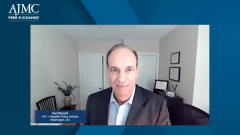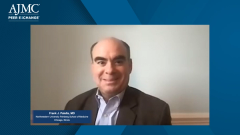
Uptake of HIV PrEP Therapy
Frank J. Palella, MD, and Ryan Bitton, PharmD, MBA, provide insight on the typical patient journey for someone who is going to receive HIV PrEP therapy and the recent increase in use of the therapy.
Episodes in this series

Ryan Haumschild, PharmD, MS, MBA: Hello and welcome to this AJMC® Peer Exchange program titled, “From Evidence to Implementation: Clarifications Around the US Preventive Services Task Force Recommendations for HIV Pre-Exposure Prophylaxis,” otherwise known as PrEP. I am Dr Ryan Haumschild, director of pharmacy services at Emory Healthcare in the Winship Cancer Institute in Atlanta, Georgia. Joining me today in this virtual discussion are my expert colleagues: Carl Schmid, executive director at HIV and Hepatitis Policy Institute in Washington, DC; Dr Frank Palella, Northwestern University Feinberg School of Medicine in Chicago, Illinois; Dr Ryan Bitton, senior director, pharmacy services, at Health Plan of Nevada in Las Vegas, Nevada; and Sean Bland, senior associate, infectious diseases initiative, at the O’Neill Institute in Washington, DC. Today, our panel of experts will discuss the patient journey and barriers to access for PrEP [pre-exposure prophylaxis] therapy. We’ll clarify the intentions of the Affordable Care Act Part 47 guidance around PrEP, and lastly, explore future opportunities to optimize access to PrEP for appropriate patients. Thank you and let’s get started.
I first want us to talk about the patient journey, how this works for the patient and what are some barriers to access. I want to talk about who’s receiving PrEP therapy and then how we’d even overcome some of these barriers that we’ve identified. As we begin, I’ll start with Frank and look for your input on what is the typical patient journey like for someone who is going to receive HIV PrEP therapy?
Frank J. Palella, MD: Thank you. That’s a great question and one for which there are a number of different potential responses. Seeking PrEP requires self-identification of risk or education as to risk, offered by health care providers. This is a different path for different individuals. Among PrEP users, White MSMs, men who have sex with men, are most heavily represented. The uptick in PrEP use has been impressive. However, populations that have yet to be impacted successfully by use of PrEP, and for whom the risk is greatest, include young MSM of color, as well as sexually active women in urban areas where the prevalence of HIV infection is high and warrants its use. Typically, either through STD [sexually transmitted disease] treatment counseling, or through ads, or peer-acquired information, a person learns of PrEP and comes to understand its potential value. Then they seek a provider, or the provider is available at the place of testing where such pre-exposure prophylaxis is offered.
Ryan Haumschild, PharmD, MS, MBA: It’s a great journey because it’s changed a lot in recent years. To your point, how do people become aware of it? How do they seek a provider? Now as they start to get educated about how to utilize it, what does it mean for them? That’s the interesting piece, how do we start to see utilization and change? Especially in the recent years. Ryan, I don’t know, from your perspective, can you tell us how have you seen PrEP usage change recently, and what are some of the factors that have played into this increase, building off what Frank mentioned?
Ryan Bitton, PharmD, MBA: That’s a very good question. We’ve seen increases in PrEP in general, the population size has grown and those seeking the therapy. It’s been brought on by education and awareness of PrEP as a term, and also as the treatments out there have been talked about and become more mainstream. We’ve seen an increase. Also the implementation of the ACA [Affordable Care Act] guidelines has made PrEP more affordable and available, and that has also led to the increase. We’ve also seen one of the products become generic, and that’s increased access as well.
Ryan Haumschild, PharmD, MS, MBA: Those are some great factors supporting use. I do agree with you. It’s interesting to see how policy starts to impact this space and identifying good therapies, sometimes that are more effective, that have shown great efficacy in this patient population and prevention. That’s interesting to see, even from your perspective, when you’re managing a benefit and seeing utilization across all of your covered members and lives.
Transcript Edited for Clarity
Newsletter
Stay ahead of policy, cost, and value—subscribe to AJMC for expert insights at the intersection of clinical care and health economics.






























































